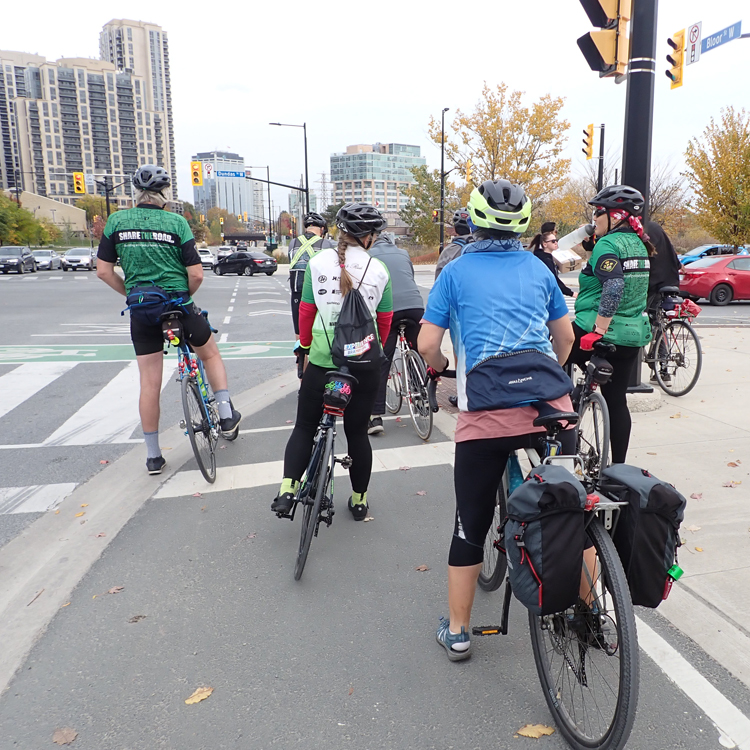BikeBrampton had 16 cyclists ride and take transit to ‘Rally & Ride for Bike Safety’ at Queen’s Park on Oct 23, 2024. Chair David Laing was amongst the speakers to more than 700 cyclists on the south lawn. Event was organized by many representatives of the Coalition for Complete Communities, including BikeBrampton.
There is a clear message to provincial government: Bike lanes save lives. Road Safety Now. Our children deserve to be safe. Vision Zero now. Research clearly shows bikes don’t cause congestion — cars do. Ministry of Transportation: Stay in your Lane. Stop Bill 212.
Economic Benefits
Bloor Annex BIA wants the bike lanes to stay – better for business! Annex Businesses tell Ford to back off their bike lanes – City News.
Health Benefits
120 physicians and researchers from University of Toronto signed this compelling letter to Premier Ford. Legislation that guides road design must prioritize safety over travel time – HealthyDebate.ca
Municipal Planning Benefits
This is “provincial overreach”, as stated by Association of Municipalities of Ontario. AMO policy statement on Bike Lanes
Municipalities have Councils, Professional Staff, and public consultations to create transportation master plans that guide how best to create safe infrastructure for all ages and abilities. The Ontario Professional Planners Institute’s statement on Bike Lanes, Oct 28. Brampton’s path aligns with this statement.
What you can Do
- Come to Brampton City Hall: Wed Nov 13th 9:30am to support the delegations. A full audience will help.
- Take a picture of yourself. Send with 2 sentences of why you like Brampton’s bike lanes to: info@bikebrampton.ca
- Write a short email/letter to your local Ward Councillors telling them you want to see a safe bike lane network in Brampton. Copy: info@bikebrampton.ca
- Email to your MPP that you don’t support Bill 212. Copy: info@bikebrampton.ca
(As of December 16th, there have been 25,803 signatures.)
Cycle Toronto says:
- Road design determines who lives and who dies in a crash
- Bike lanes are good for business
- They’re good for the environment
- They’re good for public and personal health
- They give us freedom and mobility
- Bike lanes save lives
Bike Lane Infrastructure in Brampton
On October 21st, City of Brampton has passed a motion to prevent roll-out of 2024 on-street infrastructure in Wards 2, 6, 7 & 8. Staff will limit 2025 on-street infrastructure to urban shoulders and speed cushions.
Book 18 of the Ontario Highway Traffic Act states that “Urban shoulders are not a substitute for conventional bicycle lanes, since they do not prioritize bicycle travel, and should only be treated as an interim or transitional facility“ (p.103)
Staff referred to the combination of urban shoulder and speed cushions as a “bicycle way“. Book 18 states that for a facility to be called a Bikeway there are very specific and numerous considerations outlined on pages 91 – 94. These include traffic reduction, intersection treatments, cyclist priority, speed management, and signs and pavement markings. “Speed management measures aim to reduce the speed of motor vehicle traffic on a particular roadway and bring it closer to the travel speed of people riding bikes.” There are 10 examples of speed management techniques given. Simply painting an urban shoulder and adding speed cushions without using any of the other tools does not make for a Bikeway, and will do little towards building a critical mass of cyclists in Brampton.
Additionally, Book 18 states that “Shared roadways are only
recommended for streets where motor vehicles are generally travelling at or
less than 40 km/h.“ (p.114)
See Lisa Stoke’s delegation and videos on Bike Lanes vs Urban Shoulders in our Oct 31, 2020 Blog.
Resource Links:
- Ontario Fighting Gridlock and Making Life Easier for Drivers – Bill 212 Ontario News Release
- Opinion: Ontario’s Transport Minister: We should only be putting bike lanes in places that make sense – Prabmeet Sarkaria, Toronto Star
- Doug Ford makes several exaggerated claims about Toronto bike lanes – Here’s a breakdown of the premier’s statements and the accuracy of what he said – Rochelle Raveendran, CBC News
- Bill 212 Bike Rally and Request for Action (including Induced Demand video) – Lisa Stokes blog post
- Ride and Ride for Road Safety (event report & photos) – Robert Zaichkowski, Two Wheeled Politics, A Toronto Bike Blog
- Advocacy for Respect for Cyclists Report on Rally & Ride – Joey Schwartz, ARC
- Drivers, bike lanes are not the enemy, ripping them out will only make commutes worse – Matt Bubbers (Op Ed), Globe and Mail
- New bike lane plan gets green light from Kitchener Waterloo Regional Councillors despite concerns over provincial approvals – Kate Bueckert, CBC News
- Hundreds of Cyclists attend Queen’s Park rally against proposed bike lane legislation – Meredith Bond & Michelle Mackey, City News
- You build safe streets or people die. Hundreds rally at Queen’s Park to protest plan to tear up bike lanes – Jake Edmiston, Toronto Star
- Ford’s government car-first agenda kicks cyclists to the curb – Lori Newton, Executive Director, Bike-WindsorEssex Guest column, Windsor Star
- Respecting Local Democracy and Cities – Toronto City Council adopted amended motion, Nov 13, 2024
- George and Karen Amaro’s message to Premier and Transportation Minister “Bike Lanes could have saved our daughter” – Metro Morning, CBC Oct 24th
- Bicycle Commute Triples Ford’s Stats – Robert Benzie, Toronto Star (Transportation Tomorrow Survey 2022, unpublished report), Nov 28, 2024
- The Bike lane debate isn’t a war on cycling – it’s a war on data – Sarah Elton and Madeleine Bonsma-Fisher, Globe and Mail, Nov 27, 2024
- Bike lane bill faces Charter challenge – Mahdis Habibinia, Toronto Star, Dec 12, 2024
- Cyclists file Charter challenge against Ontario government over bike lane removals – Globe and Mail, Dec 11, 2024



You must be logged in to post a comment.